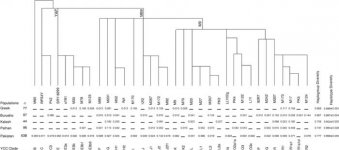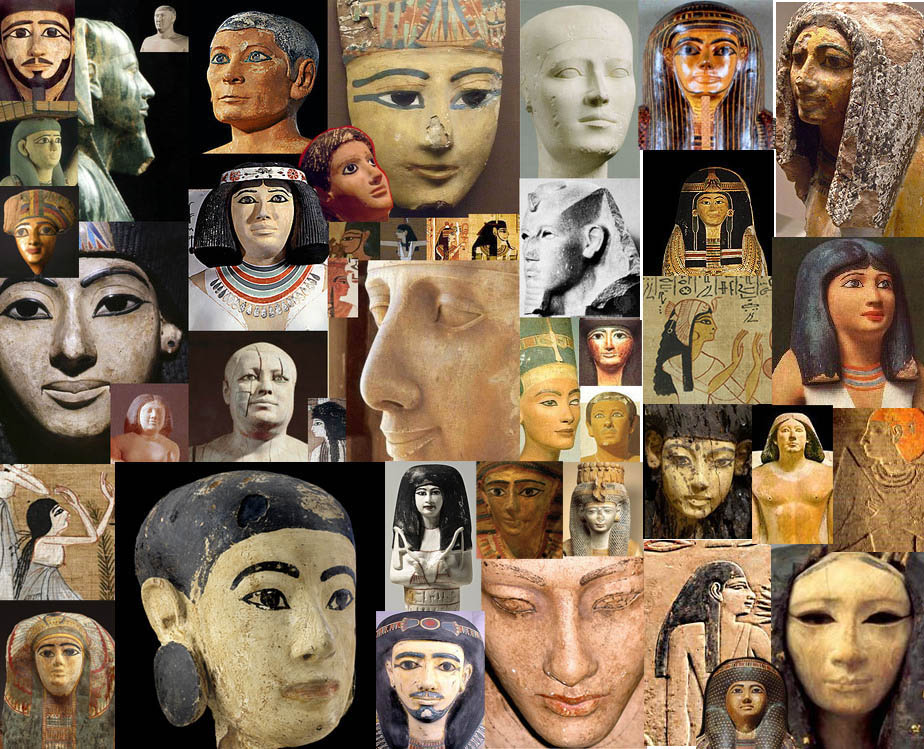Random skim
from post #42
I've never understood why some people continue to suggest that because the corpse of Ramses II and a couple of other mummies have extremely out of place hair colors (bleach blond to auburn) that they were somehow a displaced " --------END NONSENSE.
After that long garbled rant about hair, why don't you entertain us with a pic of a pure/umixed indegenous tropical negroid with long straight natural hair. I doubt you will. Nor would you be willing to explain why Maiherpri the Nubian has typical negroid hair (wig or not) as expected from someone of "tropical" origin,
as opposed to Ramses II who does not. Their hair and phenotypes set them apart.
And then, you cite a study that deals specifically with,
not an Egyptian mummy, but a female Greek mummy from Thessaloniki dated to 1700BP in yet another blatant attempt to mislead:
Journal of Archaeological Science doi:10.1016/j.jas.2008.07.003 Indications of embalming in Roman Greece by physical, chemical and histological analysis "The current colour of the hair is brown with reddish highlights, a common observation on many mummies, and probably originated through post-mortem alteration (Aufderheide, 2003; Wilson et al., 2001). Sun-exposure, bacterial reaction, and embalming methods are some of the factors that may affect the original hair colour. As a result, hair that was originally black or brown exhibits reddish, orange or even blond colour due to post mortem alterations. All human hair, however, does not turn red over archaeological time-scales (Wilson, 2001). Based on the histological analysis of the unstained hair samples, the limited fungal influence, and the macroscopic view, it can be assumed that the original hair colour was brown. Similar cases of hair preservation have been reported in studies of both mummified and non-mummified human remains (Aufderheide, 2003; Brothwell and Dobney, 1986; Lubec et al., 1987; White, 1993; Wilson et al., 2002, 2007b)."
All human hair, however, does not turn red over archaeological time-scales (Wilson, 2001)" Your own source, again, refutes your position. Even you are well familiar with the fact Ramses II hair was not the result of embalming material, but that it was
dyed red in old age
to retain his youthful appearance. Nor does your source explain away or take into account why the royals had straight/wavy hair as opposed to nappy/coiled hair -- as expected of a "tropical"/"black" population you continue to erroneously insist. Many naturally mummified bodies are discovered with genuine blonde or brown hair. But I suppose you're going to next concoct a story insisting that unmixed pure "tropical" negroids can have naturally straight/wavy hair, in addition to it being red, blonde or brown - - along with Caucasoid facial features to boot. 
I haven't found a negroid tribe yet that exhibits such characteristics. Good luck in your futile attempt.
[QUOTE["Modern scientific analysis of his [Ramses II] hair-roots has confirmed that
in his youth the king was indeed a natural red-head." (Tyldesley; 2001)
“In 1975 a 105 member team of scientists led by Lionel Baloud “restored” the mummy of Rameses II (c. 12790-1213 B.C.) and concluded, among many other points, that
his hair was of the “European” type. Some Egyptologists even maintain that Rameses II’s hair was also red, rather than dyed red.” (Najovits; 2004)
“Ramses II mummy’s hair is confined to a temporo-occipital zone which corresponds to an advanced stage of baldness. Hairs are slightly crimped and show an
oval cross-section, the great axis of which lies between 60 and 70 urn:
they are specific of a cymotrich leucoderm.” (“Scientifique à l'égyptologique” Lionel, Balout; Roubert, C., Desroches-Noblecourt, Christiane, 1985)
"Joann Fletcher, a consultant to the Bioanthropology Foundation in the UK, in what she calls an
"absolute, thorough study of all ancient Egyptian hair samples" — relied on various techniques, such as electron microscopy and chromatography to analyze hair samples. She discovered that
most of the natural hair types and those used for hairpieces were made of what she calls "Caucasian-type" hair, including even instances of blonde and red hair. Fletcher surmises that some of the lighter hair types may have been influenced by the presence of ancient Libyans and Greeks in ancient Egypt.
However, this type of hair was also found to be present in much earlier times." (Parks, Lisa. May 29, 2000. Ancient Egyptians Wore Wigs. Egypt Revealed Magazine)
"Following the latest season at the Predynastic cemetery site HK43, the anticipation felt while writing the article “Hair: Unraveling the Secrets of the Locks!” has proven to be fully justified. The work itself has involved analysis of the numerous hair samples taken during the 1997 season and new material as it was uncovered on site on an almost daily basis in 1998, with results even more significant than we could have hoped for. Work in the lab next to the courtyard began with material discovered last season; the assorted packages and containers each carefully unwrapped to reveal a whole range of fascinating hair samples. These were
examined microscopically and latest discoveries under the microscope would be discussed with those made in the field, followed up by animated, if often rather unsavory, lunch-time conversations on everything from head lice to armpit hair.
The vast majority of hair samples discovered at the site were cynotrichous (Caucasian) in type as opposed to heliotrichous (Negroid), a feature which is standard throughout dynastic times. Samples ranged from a single hair to a complete headful, with the largest number originating from the disturbed Burial no. 16, the Mudira (the directress), a female of around 35+ years of age, discovered at the end of last season." (Nekhen News 9, page 4; 1998)
“Hair was predominately used to construct the wigs and false braids which served as items of daily and funerary attire throughout the Pharaonic period (Fletcher 1995).
The hair employed for this purpose was specifically human hair, and in almost every case can be identified as cynotrichous (Caucasian) rather than heliotrichous (Negroid) (Hrdy 1978; Titlbachova and Titlbach 1977; Brunton 1937; el-Tatrawi 1935).” (“Ancient Egyptian Materials and Technology Paul Nicholson, Ian Shaw 2000)
"We are able to form a very precise idea of the structure of the body of the Proto-Egyptian (First Egyptians) … it presented
no resemblance whatever to the so-called ‘woolly’ appearance and peppercorn-like arrangement of the Negro’s hair.” (The Ancient Egyptians and Their Influence Upon European Civilization, 1911, G. Eliott Smith, Professor of Anatomy in the University of Manchester, England.)[/QUOTE]
Embalmed or not. Natural or dyed. The racial composition and color of the hair can
still be determined no matter what state it's in, your own source says so!
#42
"From a scientific perspective the concept of "race" is invalid,"
The hypocrisy and idiocy contained in your exchange is laughable. Are you so inept as a thinker and debater that you believe the existence of race debate has no bearing on a debate in which racial classification is the underlining issue?
You've repeatedly told us Egypt was "black" "black" "black" however, you now claim "black" is an invalid classification. You attached a label that you now deem arbitrary.
Since "negroes" or "blacks" do not exist, according to your own admission, ancient Egyptians could not have been "negroes" or "blacks". So this is fraud on your part since *you* claim negroid/black does not exist.
If true science does not validate "race" why are you arguing in favor of ancient Egyptians resembling a non-existent pseudo-scientific "social construct?" Your hypocrisy, double-standards and outright lies - all exposed in previous posts - is an affront to the scholarly debate you demand of your opponents. There is no logic in refuting a position that is inherently invalid by your own admission.
The south is also where the Egyptian civilization originated and where the vast majority of ancient Egypt's populations resided prior to the New Kingdom.
I've seen nothing from you yet which comes to that conclusion. "The south" is a vague remark, and you offer no evidence in support of it. The oldest habitation was in the north (discussed already). And Keita, who you quoted earlier is in complete disagreement with you.
"Lower Nubia had a much smaller population than Egypt, which is important to consider in writing of the historical biology of the population" (Keita; 2005)
Comments like this generated laughter in this seminar of Kemet at Manchester (UK), who have recently accepted and embrace the fact that ancient Egypt (or Kemet) was a black African civilization.
Sally-Ann Ashton (nor her photographer lackey) couldn't even support nor was willing to defend her laughable position in a basic email exchange. Notably, in the 14:53 waste you posted, Ashton failed to reference a single source in support of her claims.
And the "comments" you fallaciously attribute the "laughter" - of a black audience she is appealing to, (in addition to a black prison population according to the website) have nothing to do with a "black" Egypt but Astons' erroneous conclusion, in fantasizing Cleopatra as some sort of mulatto.
Black Cleopatra Debunked:
Refuting 'Black to Kemet' Fitzwilliam Museum expo:
Egyptians: Which Side of the Vase?:








